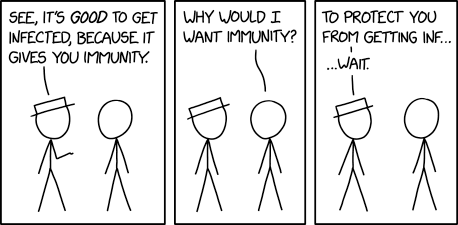
Image from @flavia_feijo_epi@med-mastodon.com.
Last updated 2025/12/13 (see section: 6.7.1).
-
SARS-CoV-2 is airborne.
(Nature, 2022; WHO, 2024)-
The CDC has recommended "at least 5 air changes per hour of clean air in occupied spaces" and published a table of cost considerations for various ventilation and air filtration strategies.
(CDC as of 2023/05/12) -
Transmission is overwhelmingly airborne. "We investigated the level of SARS-CoV-2 contamination in the hands of 925 healthy individuals. Although viral RNA debris was identified, its frequency and copy number were extremely low, and no viable SARS-CoV-2 was detected. Thus, our results indicate that the risk of infection through contact transmission of SARS-CoV-2 via hands is relatively low. Therefore, infection control measures for COVID-19 should focus on preventing droplet and aerosol transmission."
(Springer Nature Group, 2024)-
Between October 2019 and October 2022, 70.4% of household transmissions in the US were sourced back to children.
(JAMA, 2023)
-
Between October 2019 and October 2022, 70.4% of household transmissions in the US were sourced back to children.
-
The higher the concentration of indoor CO2, the longer the virus remains infectious in the air.
(Nature Communications, 2024)
-
The CDC has recommended "at least 5 air changes per hour of clean air in occupied spaces" and published a table of cost considerations for various ventilation and air filtration strategies.
-
It can spread before and without symptoms.
(JAMA, 2020; JAMA, 2021; Public Health, 2022; CDC, 2022) -
The FDA recommends repeat testing in 48 hour intervals following a negative rapid test to reduce the risk of a false negative result.
(FDA as of 2022/11/17)-
Rapid tests that rely on nasal swabs have been prone to false negatives early in infection.
(Microbiology Spectrum via Caltech, 2023) -
"[Test] sensitivity estimates were 30.0-60.0% on the first day, 59.2-74.8% on the third day, and 80.0-93.3% on the fourth day of symptoms."
(Clinical Infectious Diseases, 2023) -
"Health professionals and the public should be aware that package inserts for SARS-CoV-2 RATs might provide an overly optimistic picture of the sensitivity of a test. Regulatory bodies should strengthen their requirements for the reporting of diagnostic accuracy data in package inserts and policy makers should demand independent validation data for decision making."
(The Lancet Microbe, 2023)
-
Rapid tests that rely on nasal swabs have been prone to false negatives early in infection.
-
Vaccinated and/or previously infected individuals have remained highly infectious upon subsequent infection, while individuals without any history of vaccination or infection have been the most infectious.
(Nature Medicine, 2023)-
"The primary goal of the COVID-19 vaccination program is to prevent severe illness and death" and "symptomatic SARS-CoV-2 infection," not asymptomatic/subclinical infection.
(CDC as of 2024/07/12)-
Vaccines have helped prevent acute endothelial dysfunction in hospitalized patients.
(Current Pharmaceutical Design, 2022) -
Vaccination has been far safer than infection.
(The Lancet Infectious Diseases, 2022; Nature, 2023) -
Prior infection has limited the benefit of mRNA vaccination.
(Immunity, 2023)
-
Vaccines have helped prevent acute endothelial dysfunction in hospitalized patients.
-
"The primary goal of the COVID-19 vaccination program is to prevent severe illness and death" and "symptomatic SARS-CoV-2 infection," not asymptomatic/subclinical infection.
-
SARS-CoV-2 is capable of asymptomatic/subclinical persistence, regardless of vaccination status. "Factors that differentiate SARS-CoV-2 persistence in PASC from persistence in asymptomatic individuals should be explored."
(Nature Immunology, 2023)-
There is no available evidence that the immune system is capable of fully clearing SARS-CoV-2, regardless of vaccination status. The study cited below defines 'clearance' as no longer shedding detectable amounts of RNA, which is not the same as full viral clearance, since viruses are capable of persisting and replicating intracellularly.
(Signal Transduction and Targeted Therapy, 2023)
-
There is no available evidence that the immune system is capable of fully clearing SARS-CoV-2, regardless of vaccination status. The study cited below defines 'clearance' as no longer shedding detectable amounts of RNA, which is not the same as full viral clearance, since viruses are capable of persisting and replicating intracellularly.
-
Clinically "mild" covid (NIH: "any of the various signs and symptoms of COVID-19 [e.g., fever, cough, sore throat, malaise, headache, muscle pain, nausea, vomiting, diarrhea, loss of taste and smell"]) has caused:
-
Immune dysfunction & dysregulation:
(PLOS Pathogens, 2021; Nature Immunology, 2022; Nature Immunology, 2024; Nature Communications, 2024; medRxiv, 2023 & Science Translational Medicine, 2024; Allergy, 2024; Journal of Leukocyte Biology, 2024; Frontiers in Immunology, 2025; International Journal of Infectious Diseases, 2025)-
The immune system is not analogous to a muscle that needs to be used to be kept in shape (AKA "immunity debt"), and there is no material benefit to any amount of viral infections.
(Financial Times via archive.today], 2022; Global News, 2022; Johns Hopkins Bloomberg School of Public Health, 2022; McGill Office for Science and Society, 2022; JAMA, 2024) -
"For the 2022 study population (average age 2.4 years, 46.8% girls, 61% white, 16% black), the risk for incident RSV infection during October 2022–December 2022 was 6.40% for children with prior COVID-19 infection, higher than 4.30% for the matched children without COVID-19."
(Family Medicine and Community Health, 2023) -
"Throughout the pandemic, scientific evidence has mounted that even mild COVID infections may be doing something to our immune systems, as well as our collective immunity."
(Memorial Sloan Kettering Cancer Center Library, 2023) -
"Booster vaccine doses did not decrease autoantibody responses in patients with breakthrough infections, suggesting that vaccination cannot be used to combat autoimmunity resulting from exposure to SARS-CoV-2."
(Immunohorizons, 2024)
-
The immune system is not analogous to a muscle that needs to be used to be kept in shape (AKA "immunity debt"), and there is no material benefit to any amount of viral infections.
-
Chronic pro-inflammatory gene expression:
(Genome Medicine, 2023) -
Accelerated biological aging:
(International Journal of Molecular Sciences, 2021; Nature Communications, 2022; PNAS, 2023; Frontiers in Cellular Neuroscience, 2024) -
Cognitive and memory deficits:
(New England Journal of Medicine, 2024) -
Subjective memory loss:
(Neurología, 2024) -
Long-term physical, cognitive, and psychiatric outcomes:
(The Lancet Regional Health, 2024) -
Damage to:
-
The brain & nervous system:
(JAMA Psychiatry, 2021; International Journal of Molecular Sciences, 2021; Nature Medicine, 2022; Signal Transduction and Targeted Therapy, 2022; Neuroscience and Biobehavioral Reviews, 2023; Neurology, 2023; Cell Death Discovery, 2023; Journal of Magnetic Resonance Imaging, 2023; Computers in Biology and Medicine, 2024; Cell Stem Cell, 2024; Brain Communications, April 2024; Brain Communications, May 2024; Institutional Repository in Medical Sciences, 2025)-
Gray matter/astrocytes:
(PNAS, 2022) -
The blood-brain barrier:
(Journal of Neuroinflammation, 2022; Journal of Neuroinflammation, 2023; Nature Neuroscience, 2024; MedComm, 2024) -
The vagus nerve:
(PLOS One, 2023) -
Cognition, verbal working memory, attention, and response:
(MDPI, 2025) -
Despite vaccination:
(Nature Scientific Reports, 2024; Cell Host & Microbe, 2024)
-
Gray matter/astrocytes:
-
Blood vessels:
-
Capillary clotting:
(Biochemical Journal, 2022) -
Arterial stiffness:
(Journal of Clinical Medicine, 2023) -
Vascular damage and red blood cell turnover:
(bioRxiv [Institute for Medical Research, Israel-Canada], 2023)
-
Capillary clotting:
-
The heart:
(Journal of Virology, 2022; Circulation Research, 2023; Cardiovascular Diagnosis & Therapy, 2024 [study cohort: people undergoing heart surgery 6 months post-recovery from the Omicron wave in China; initial symptom severity unknown; includes viral persistence in cardiac tissue]; Nature Microbiology, 2024; Hearts, 2024; Microorganisms, 2024) -
The lungs:
(The Journal of Infectious Diseases, 2024) -
The kidneys:
(Nature Reviews Nephrology, 2021) -
The liver:
(Nature Reviews Gastroenterology & Hepatology, 2021; Nature Scientific Reports, 2021; Virology Journal, 2021; World Journal of Gastroenterology, 2021; World Journal of Gastroenterology, 2024 ) -
The eyes:
(PLOS Pathogens, 2024) -
Mechanisms that play a crucial role in preventing cancer:
(Microorganisms, 2023; International Journal of Molecular Sciences, 2023; Frontiers in Molecular Biosciences, 2023; Biochimie, 2023; Cell Communication and Signaling, 2024)
-
The brain & nervous system:
-
Subclinical organ damage:
(Medical Review, 2024)-
Lasting multi-organ impairment:
(Journal of the Royal Society of Medicine, 2023) -
Occult hyposmia/olfactory dysfunction:
(JAMA, 2025)
-
Lasting multi-organ impairment:
-
Cumulative damage upon subsequent infection:
(Nature Medicine, 2022) -
"Substantial health and economic burden during the year after acute illness."
(BMC Medicine, 2024) -
An increased risk of:
-
Heart disease and stroke:
(JAMA Neurology, 2021; Nature Medicine, 2022; Nature Communications, 2025) -
Diabetes, including pediatric:
(CDC, 2022; JAMA, 2022; The Lancet Diabetes and Endocrinology, 2022; BioMedicine, 2023; JAMA, 2023; JAMA, 2023; Frontiers in Public Health, 2023; Journal of Medical Virology, 2023; Journal of Clinical Endocrinology & Metabolism, 2023; JAMA, 2024; Cell Stem Cell, 2024) -
Gastrointestinal disorders:
(Nature Scientific Reports, 2024) -
Autoimmunity:
(Nature Reviews Rheumatology, 2023; JAMA Dermatology, 2024) -
Neurodegeneration:
(The Lancet Neurology, 2024) -
Serious health complications and premature death:
(JAMA Health Forum, 2023; The Lancet Infectious Diseases, 2025)-
Australia reported an excess mortality rate of 7% for the first six months of 2023, and 5% for the entire year.
(Actuaries Institute, 2023; Actuaries Institute, 2024) -
"Some deaths [in the United States] attributable to SARS-CoV-2 infection may have gone unrecognized by death investigators as COVID-19 deaths due to limited COVID-19 testing, atypical presentation of symptoms, comorbidities, limited resources for death investigation in out-of-hospital settings, and stigma or political beliefs about COVID-19."
(PNAS, 2024)
-
Australia reported an excess mortality rate of 7% for the first six months of 2023, and 5% for the entire year.
-
Heart disease and stroke:
-
Immune dysfunction & dysregulation:
-
"Hundreds of patients died after catching COVID in Victorian hospitals. [...] Almost one in 10 patients who caught COVID in hospital died. [...] Compared to staff wearing surgical masks and not screening patients on admission, the combination of wearing N95 masks and testing patients using RATs was the cheapest, saving an estimated $78.4 million and preventing 1,543 deaths statewide per year. Staff wearing N95s and screening patients with PCR tests was the most effective option, saving $62.6 million and preventing 1,684 deaths per year."
(ABC News, 2024)-
"At least 6,007 patients caught COVID in NSW public hospitals in 2023 and 297 died — about 115 infections and six deaths per week, on average. Experts say infection control protocols are not good enough, with some doctors warning widespread indifference to COVID is costing too many lives and adding unnecessary pressure to the health system."
(ABC News, 2024)
-
"At least 6,007 patients caught COVID in NSW public hospitals in 2023 and 297 died — about 115 infections and six deaths per week, on average. Experts say infection control protocols are not good enough, with some doctors warning widespread indifference to COVID is costing too many lives and adding unnecessary pressure to the health system."
-
"26 participants remained seronegative, despite the testing of up to 3 samples per person for IgA, IgM, and IgG against multiple antigens as well as neutralizing antibodies. Thus, 36% of our cohort represented serologic nonresponders. [...] We also show that clinical illness does not guarantee seroconversion and that laboratories with highly sensitive RT-PCR assays are more likely to detect serologic nonresponders. These results provide an explanation for the puzzling variability of seroconversion in different cohorts."
(Emerging Infectious Diseases, 2021)-
"... among patients with mild COVID-19, children may be less likely to have seroconversion than adults despite similar viral loads. This finding has implications for future protection after SARS-CoV-2 infection in children and for interpretation of serosurveys that involve children."
(JAMA, 2022) -
"45% of infected (338/751) and 33% of uninfected (48/147) school-age children and 39% of infected (1219/3109) and 27% of uninfected (372/1369) adolescents [between March 2022 and December 2023] reported having at least 1 prolonged symptom [>90 days]. [...] Infected participants were not required to have evidence of SARS-CoV-2 infection; this study relied on caregiver-reported COVID-19 infection history, given variable access to testing. Uninfected children were confirmed to not have SARS-CoV-2 antibodies, but it is possible that some may have been unknowingly infected without developing antibodies or their immunity waned."
(JAMA, 2024)
-
"... among patients with mild COVID-19, children may be less likely to have seroconversion than adults despite similar viral loads. This finding has implications for future protection after SARS-CoV-2 infection in children and for interpretation of serosurveys that involve children."
-
Between August 1, 2021 and July 31, 2022, "among children and young people aged 0 to 19 years in the US, COVID-19 ranked eighth among all causes of deaths, fifth in disease-related causes of deaths, and first in deaths caused by infectious or respiratory diseases," accounting for 2%, or 1 in 50 deaths in this age group.
(JAMA Public Health, 2023) -
"The NIH defines the PASC as symptoms or conditions which may reflect exacerbation of underlying conditions, persistent symptoms of acute infection, or may be new symptoms or conditions arising de novo, distinct from the acute SARS-CoV-2 infection period."
(Pediatrics, 2024)-
Between March 2022 and December 2023, out of 898 children age 6 to 11 (mean age 8.6), 10 key long covid symptoms were identified: trouble with memory or focus, back or neck pain, stomach pain, headaches, phobias, refusal to go to school (which Gross says may be an indicator of larger issues), itchy skin or rash, trouble sleeping, nausea or vomiting, and lightheadedness or dizziness. Out of 4,469 adolescents age 12-17 (mean age 14.8), eight key symptoms were identified: change or loss of smell or taste, body/muscle/joint pain, daytime sleepiness or low energy, fatigue after walking, back or neck pain, trouble with memory or focus, headaches, and lightheadedness or dizziness.
(JAMA, 2024) -
Out of 40 studies worldwide that assessed "the prevalence of any symptom" among 12,424 children and adolescents, as of December 11th, 2022, 15% suffered at least 1 symptom at least 1 year after infection.
(Journal of Infection and Public Health, 2023) -
Out of 31 studies worldwide (including preprints) that assessed "more than 20 persistent symptoms and clinical features" among 15,000 children and adolescents, as of December 2022, 16% suffered at least 1 symptom at least 3 months after infection.
(Pediatrics, 2023) -
Between January 2021 and April 2022, 7.8% (1 in 13, or 6 in 77) of children with subclinical infections suffered at least one symptom at least 3 months after follow-up.
(Clinical Infectious Diseases via CIDRAP, 2024)
-
Between March 2022 and December 2023, out of 898 children age 6 to 11 (mean age 8.6), 10 key long covid symptoms were identified: trouble with memory or focus, back or neck pain, stomach pain, headaches, phobias, refusal to go to school (which Gross says may be an indicator of larger issues), itchy skin or rash, trouble sleeping, nausea or vomiting, and lightheadedness or dizziness. Out of 4,469 adolescents age 12-17 (mean age 14.8), eight key symptoms were identified: change or loss of smell or taste, body/muscle/joint pain, daytime sleepiness or low energy, fatigue after walking, back or neck pain, trouble with memory or focus, headaches, and lightheadedness or dizziness.
-
As of August 2023, out of 17 studies worldwide involving 444,211, 9.3% were affected for an indefinite period following infection. "The odds of mental health conditions and brain fog significantly increased over time. The odds for brain fog being diagnosed significantly increased when validated instruments and cognitive tests were used. The odds of brain fog significantly decreased with increasing vaccination rates."
(General Hospital Psychiatry, 2024)-
Among a vaccinated subcohort of 4,725 adults (median age 47) infected on or after 1 December 2021, 16% met the criteria for postacute sequelae 6 months later.
(JAMA, 2023) -
Between December 2019 and September 2021, among "publications about COVID-19 in online databases 'Medline'/'PubMed' and 'Scopus,'" 30-60% of patients experienced "Post COVID-19 Syndrome."
(Pathogens, 2021) -
Among outpatients in the US between December 30, 2020 and January 28, 2022, treatment with metformin — a drug used to treat type 2 diabetes — reduced the incidence of long COVID by ~41% in a decentralized, randomized, quadruple-blind, parallel-group, phase 3 trial.
(The Lancet Infectious Diseases, 2023)
-
Among a vaccinated subcohort of 4,725 adults (median age 47) infected on or after 1 December 2021, 16% met the criteria for postacute sequelae 6 months later.
-
As of August 2022, according to medical billing records from Japan, the reinfection rate for the Omicron lineage has been 3.7 months, or about 3 times a year.
(Kyodo News, 2023) -
The US Department of Health and Human Services considers "Long COVID" a disability under the ADA.
(HHS as of 2021/07/) -
The US CDC is no longer tracking reported cases, focusing instead on hospitalizations and deaths.
(CDC as of 2023/05/11)-
In September 2022, the number of reported cases were a quarter of what they were at their peak the winter before. The director of the Institute for Health Metrics and Evaluation estimated that only 4% to 5% of infections were being reported, because many of the infections uncovered through at-home tests either weren't reported to public health departments, or weren't detected at all.
(NBC News, 2022)
-
In September 2022, the number of reported cases were a quarter of what they were at their peak the winter before. The director of the Institute for Health Metrics and Evaluation estimated that only 4% to 5% of infections were being reported, because many of the infections uncovered through at-home tests either weren't reported to public health departments, or weren't detected at all.
-
The Memorial Sloan Kettering Cancer Center Library has compiled "detailed information and resources on the long-term health consequences of COVID-19 infection and the broad social impacts of the COVID-19 pandemic."
(Memorial Sloan Kettering Cancer Center as of 2024/04/15)


